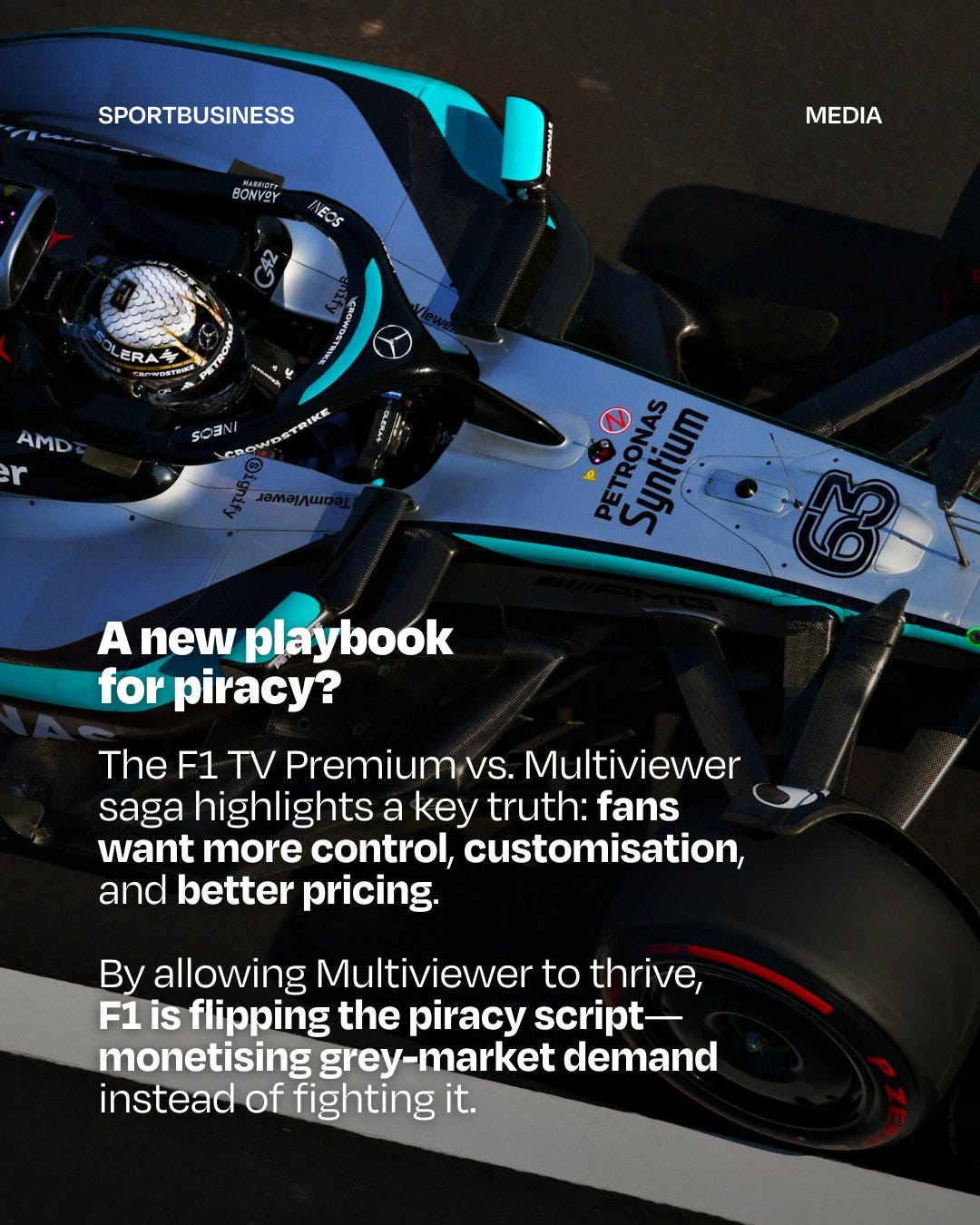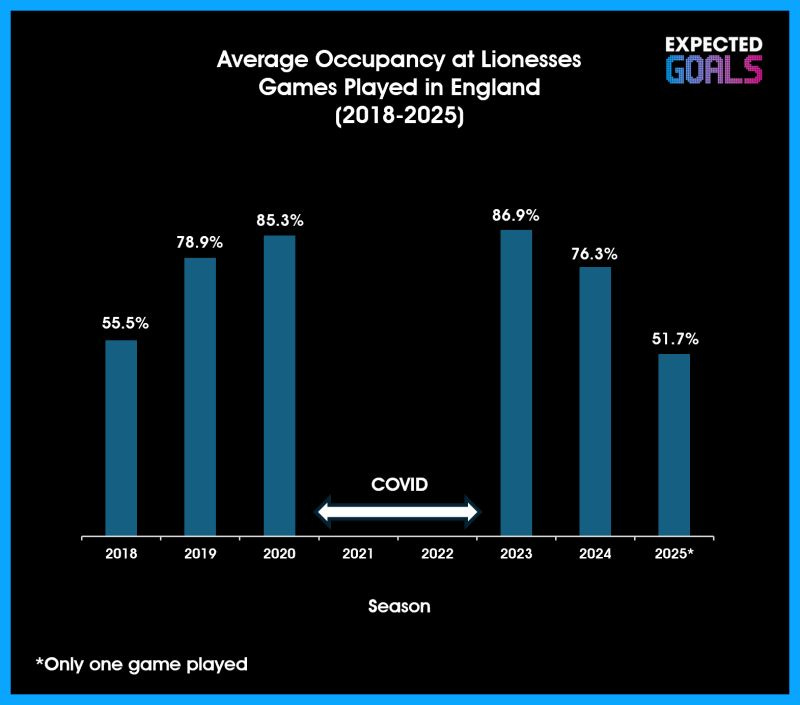F1's deal with the pirates; Map v Territory; FOMO alert; Robert Rock's hair; UP x Sportico = Transatlantic: Last Dance v Air; Jordan's revisionist history; Private equity closes the agent loop
Overthinking the sports business, for money
Another room you can’t get in to
Unofficial Partner is off to Bratislava next week to record the Sports Media Brainstorm live on stage at the EBU’s Annual Sports Assembly.
Can’t wait.
We’ve got a great set of guests and a provocative, timely topic.
What is free-to-air sport in the YouTube era?
The resulting podcast will follow.
Interesting story of the week
The prize goes to F1 and Multiviewer, (and a well done to SportBusiness for both the story and the presentation of the story across their social channels).
The point of the story is a major rights holder’s relationship with piracy.
The Number’s Always Wrong
When Matt Cutler and I did Pirates vs The Premier League series, it became clear that there’s a data gap.
Put another way, there’s not enough of it to give you a secure feeling that the map was a reliable picture of the territory.
Basically, all roads lead to a single piece of work carried out in 2022 by Ampere Analysis and Synamedia. No shade on them btw, it’s a really solid bit of work. I’m just pointing out how influential this single source has become in framing the issue.
The headline number from this research is used as the defacto truth:
Beyond the headline though there’s one stat in particular that gets quoted.
I use it a lot in podcasts and elsewhere, and it has become my go-to ‘fact’ when asked about piracy.
“54% of people downloading illegal streams also pay for the legal service”
I like this number because it’s slyly counterintuitive. It has echoes of the stat about ‘most people on benefits are also in work’. Both are the start of a story that takes us further, adding nuance to the y/n binary.
It’s backed up by other data points:
Football is the star sports piracy attraction and, despite being available on free-to-air TV in many markets, FIFA World Cup it is the most pirated league according to the findings. This reflects its popularity globally but indicates that even free content can suffer from piracy if fans already use illegal sites to access other sports content. UEFA Champions League and the English Premier League are second and third respectively.
The ‘54% do both’ stat is a bridge out of ‘this lot are criminals’ and in to ‘give us Spotify for Sport’ type middle class dinner party conversations (and podcasts).
But is that number right?
I don’t know. The number’s always wrong and all that.
What’s interesting though is that this data point appears to be the basis of the decision by F1 to engage with the ‘grey market’ product rather than try to sue their own viewers, which as we know is a bad look.
The Premier League and other big rights holders are in a horrible position, damned if they do etc, their TV rights buyers want something done to stem the leak but it’s a PR nightmare. There’s no votes in it for politicians and the police get it in the neck - ‘my bike’s been nicked and you’re spending your time protecting Todd Boehly’s money’. Etc.
Such talk really annoys the big rights holders, and rightly so.
Stealing is stealing, as Richard Scudamore put in our podcast with him.
‘You wouldn’t go in to a supermarket and nick stuff and expect to get away with it’.
Which is true, obvs.
At the other end of the piracy supply chain are the worst people in the world, drug lords and human traffickers.
Which is why piracy is one of the single most interesting stories in the sports business: it can carry many of the other trends and themes, and requires heroic levels of cognitive dissonance among people like me - see ‘middle class dinner parties’ above.
Wedge Issues: Robert Rock has expensive hair
We know this because he never wears a cap.
A golfer without a cap is like a something without a something (this is a placeholder for a joke that I can’t be bothered to think of. But you get the point, it’s an advertising space without an advert. What would that be, only funny).
Anyway, the point is, he’s put a number on his decision to go hatless.
Jordan’s revisionist history
Talking with Sonny Vaccaro for this week’s podcast meant questioning one of the great sports business stories.
Vaccaro was the man who signed Michael Jordan to Nike in 1984. That deal, the one which continues to make $7billion a year for the company, from which Jordan takes 5% a year.
The podcast is here.
The Jordan story has been told many times.
Recently, it has been the source material for two big media moments: The Last Dance documentary series and Air the movie made by Ben Affleck and Matt Damon, who played Vaccaro in the film.
Back to the question re piracy above, which version is the reliable source?
Vaccaro, now 83, claims that Phil Knight and Nike has tried to minimize his role in the Jordan deal and Jordan’s growth into a global phenomenon—an allegedly revisionist history that, for Vaccaro, boiled over when he was cut entirely from ESPN’s 10-part doc The Last Dance.
Vaccaro: There’ve been a lot of things written that aren’t necessarily correct about me. So we were nervous. We got double-crossed by the people in The Last Dance. They sent a whole crew to Palm Springs and I talked [on camera] for three and a half hours. I was dubious because I hadn’t talked to anybody at Nike for years. Well, the end result was, in The Last Dance, all you could see was my rear end. They never used anything that I said.
The Jordan legacy is fiercely protected.
Football agency consolidation: Private Equity is closing the loop
Daniel Geey has done a good piece based on his recent appearance on Other People’s Money, alongside former MTV executive and regular co-host Matt Rogan.
The podcast is here.
Dan’s build is here.
The key takeaway is what private equity wants, or more accurately, how things shift to give p/e what it wants.
In this case, it’s scale and stability. So, they’re buying up football agents and management businesses.
Two things happen. It gets beyond the traditional problem that it’s a flaky model,
One of the biggest vulnerabilities for traditional football agencies is instability. Unlike club contracts, which can span several years, player representation agreements last a maximum of two years. That means an agent’s biggest risk and opportunity are their clients and potential clients.
For smaller agencies, this creates uncertainty and insecurity. But for larger agencies the risk is spread across hundreds of players. Losing one or two high-profile clients becomes less of a concern when you have a larger share of the overall talent pool.
“What you don’t want to have as an agency is three or four incredibly good players on two-year deals,” I explained. “You want 500 players constantly renewing their representation contracts to de-risk your client base.”
This is why private equity is swooping in. Scale equals (a degree of) security, and in a business as unpredictable as football, security is a rare commodity.
Clubs Are Subsidising Agents—And It’s All Cyclical
This though, is the best bit.
One of the ironies of football finance is that while clubs (and/or their fans) sometimes berate the high level of agent commission, they are underpinning the agency business model. Clubs are losing money, year after year, yet they continue to pay large commissions to agents. Why? Because they believe these fees will help them land the right players, which in turn helps clubs compete and boost their revenues through prize money, broadcasting deals and commercial partnerships.
“It’s not the players making losses—it’s clubs,” I pointed out. “Clubs are basically subsidising agencies. And ironically, [you could argue] it’s private equity subsidising private equity.”
When PE firms invest in clubs and agencies at the same time, some believe it creates a closed-loop system where both sides are indirectly fuelling each other’s business models.
Transatlantic
Something happens when sports business stories travel across the Atlantic.
Things go a bit wrong. Nuance is lost. Cliches abound.
It’s because we’re not close enough to the stories. We start guessing, or working to the middle, moving away from the specific to the abstract but safer ground of received wisdoms and theories.
That works both ways. I don’t know enough about the NFL and NBA to get really in to the story.
Likewise, when I read European football stories or tropes like cricket and rugby ‘breaking America’ type stuff, there’s a limit to how close they can get to the real stuff.
Given the race for the global fan, this seems like a big gap.
So, I went on Sportico to make the point.
Have you been following Matt Cutler this week?
You should.
The Expected Goals co-host is giving good graph.
Now click the Like button below
Literally, you’ve got one job.












